I was looking for a derivation of the expression for the energy density at any point in a static magnetic field. I do know that it is $$u_B=\dfrac {1}{2 \mu_0}\left|\mathbf{B}\right|^2,$$ I was just wondering if there was a derivation that could be built up the way one derives the energy density, $$u_E=\dfrac {\epsilon_0}{2}\left|\mathbf{E}\right|^2$$ at any point in an electric field, by considering the energy needed to build up a 'source' charge bit by infinitesimal bit.
Whatever proof I have come across seems to bring inductance into the picture -- is there a way of doing it without that? I ask because the corresponding proof for the electric field does not seem to need the definition of capacitance anywhere.


